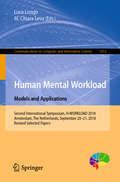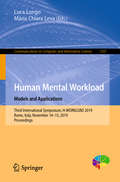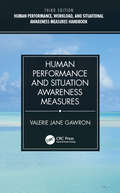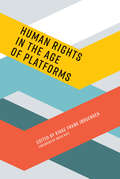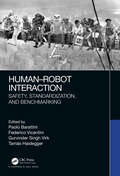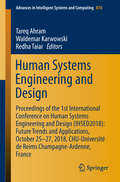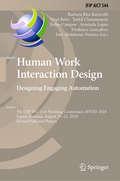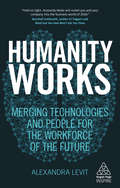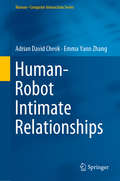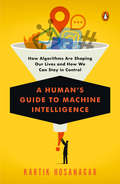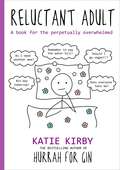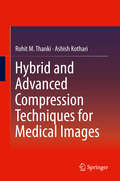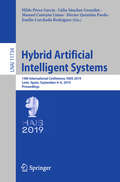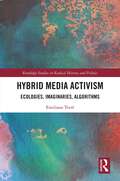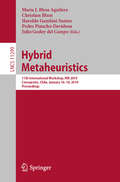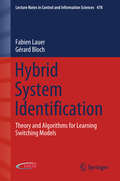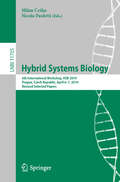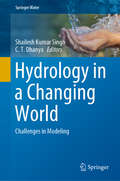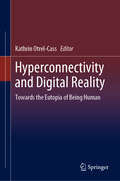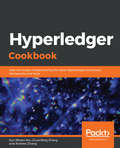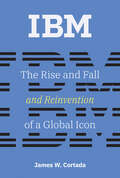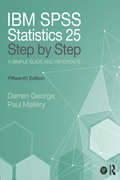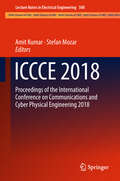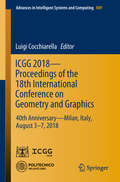- Table View
- List View
Human Mental Workload: Second International Symposium, H-WORKLOAD 2018, Amsterdam, The Netherlands, September 20-21, 2018, Revised Selected Papers (Communications in Computer and Information Science #1012)
by Luca Longo M. Chiara LevaThis book constitutes the refereed proceedings of the Second International Symposium on Human Mental Workload: Models and Applications, H-WORKLOAD 2018, held in Amsterdam, The Netherlands, in September 2018. The 15 revised full papers presented together with one keynote were carefully reviewed and selected from 31 submissions. The papers are organized in two topical sections on models and applications.
Human Mental Workload: Third International Symposium, H-WORKLOAD 2019, Rome, Italy, November 14–15, 2019, Proceedings (Communications in Computer and Information Science #1107)
by Luca Longo Maria Chiara LevaThis book constitutes the refereed proceedings of the Third International Symposium on Human Mental Workload: Models and Applications, H-WORKLOAD 2019, held in Rome, Italy, in November 2019.The volume presents one keynote paper as well as 14 revised full papers, which were carefully reviewed and selected from 32 submissions. The papers are organized in two topical sections on models and applications.
Human Performance and Situation Awareness Measures
by Valerie GawronThis book was developed to help researchers and practitioners select measures to be used in the evaluation of human/machine systems. The book begins with an overview of the steps involved in developing a test to measure human performance. This is followed by a definition of human performance and a review of human performance measures. Another section defines situational awareness with reviews of situational awareness measures. For both the performance and situational awareness sections, each measure is described, along with its strengths and limitations, data requirements, threshold values, and sources of further information. To make this reference easier to use, extensive author and subject indices are provided. <P><P>Features <li>Provides a short engineering tutorial on experimental design <li>Offers readily accessible information on human performance and situational awareness (SA) measures <li>Presents general description of the measure <li>Covers data collection, reduction, and analysis requirements <li>Details the strengths and limitations or restrictions of each measure, including proprietary rights or restrictions
Human Rights in the Age of Platforms (Information Policy)
by Rikke Frank JørgensenScholars from across law and internet and media studies examine the human rights implications of today's platform society.Today such companies as Apple, Facebook, Google, Microsoft, and Twitter play an increasingly important role in how users form and express opinions, encounter information, debate, disagree, mobilize, and maintain their privacy. What are the human rights implications of an online domain managed by privately owned platforms? According to the Guiding Principles on Business and Human Rights, adopted by the UN Human Right Council in 2011, businesses have a responsibility to respect human rights and to carry out human rights due diligence. But this goal is dependent on the willingness of states to encode such norms into business regulations and of companies to comply. In this volume, contributors from across law and internet and media studies examine the state of human rights in today's platform society.The contributors consider the “datafication” of society, including the economic model of data extraction and the conceptualization of privacy. They examine online advertising, content moderation, corporate storytelling around human rights, and other platform practices. Finally, they discuss the relationship between human rights law and private actors, addressing such issues as private companies' human rights responsibilities and content regulation.ContributorsAnja Bechmann, Fernando Bermejo, Agnès Callamard, Mikkel Flyverbom, Rikke Frank Jørgensen, Molly K. Land, Tarlach McGonagle, Jens-Erik Mai, Joris van Hoboken, Glen Whelan, Jillian C. York, Shoshana Zuboff, Ethan ZuckermanOpen access edition published with generous support from Knowledge Unlatched and the Danish Council for Independent Research.
Human-Robot Interaction: Safety, Standardization, and Benchmarking
by Paolo Barattini Federico Vicentini Gurvinder Singh Virk Tamas HaideggerHuman-Robot Interaction: Safety, Standardization, and Benchmarking provides a comprehensive introduction to the new scenarios emerging where humans and robots interact in various environments and applications on a daily basis. The focus is on the current status and foreseeable implications of robot safety, approaching these issues from the standardization and benchmarking perspectives. Featuring contributions from leading experts, the book presents state-of-the-art research, and includes real-world applications and use cases. It explores the key leading sectors—robotics, service robotics, and medical robotics—and elaborates on the safety approaches that are being developed for effective human-robot interaction, including physical robot-human contacts, collaboration in task execution, workspace sharing, human-aware motion planning, and exploring the landscape of relevant standards and guidelines. <P><P>Features <P><P>Presenting a comprehensive introduction to human-robot interaction in a number of domains, including industrial robotics, medical robotics, and service robotics <P><P>Focusing on robot safety standards and benchmarking <P><P>Providing insight into current developments in international standards <P><P>Featuring contributions from leading experts, actively pursuing new robot development
Human Systems Engineering and Design: Proceedings of the 1st International Conference on Human Systems Engineering and Design (IHSED2018): Future Trends and Applications, October 25-27, 2018, CHU-Université de Reims Champagne-Ardenne, France (Advances in Intelligent Systems and Computing #876)
by Redha Taiar Waldemar Karwowski Tareq AhramThis book focuses on novel design and systems engineering approaches, including theories and best practices, for promoting a better integration of people and engineering systems. It covers a range of hot topics related to: development of activity-centered and user-centered systems; interface design and human-computer interaction; usability and user experience; cooperative, participatory and contextual models; emergent properties of human behavior; innovative materials in manufacturing, and many more. Particular emphasis is placed on applications in sports, healthcare, and medicine. The book, which gathers selected papers presented at the 1st International Conference on Human Systems Engineering and Design: Future Trends and Applications (IHSED 2018), held on October 25-27, 2018, at CHU-Université de Reims Champagne-Ardenne, France, provides researchers, practitioners and program managers with a snapshot of the state-of-the-art and current challenges in the field of human systems engineering and design.
Human Work Interaction Design. Designing Engaging Automation: 5th IFIP WG 13.6 Working Conference, HWID 2018, Espoo, Finland, August 20 - 21, 2018, Revised Selected Papers (IFIP Advances in Information and Communication Technology #544)
by Barbara Rita Barricelli Virpi Roto Torkil Clemmensen Pedro Campos Arminda Lopes Frederica Gonçalves José Abdelnour-NoceraThis book constitutes the thoroughly refereed post-conference proceedings of the 5th IFIP WG 13.6 Working Conference on Human Work Interaction Design, HWID 2018, held in Espoo, Finland, in August 2018.The 19 revised and extended full papers presented were carefully selected for inclusion in this volume. The papers deal with the analysis and interaction design of a variety of complex work and life contexts found in different business and application domains. They focus on interaction design for work engagement taking usability of interactive systems to the next level by providing employees pleasurable and meaningful experiences via the tools used at work. The papers are organized in two sections: the first section presents cases of HWID in practice, while the second one focuses on methodological discussion.
Humanity Works: Merging Technologies and People for the Workforce of the Future (Kogan Page Inspire)
by Alexandra LevitThe professional landscape is transforming, and the only way to maintain competitive advantage is to maximize the unique skills of your workforce. In Humanity Works, bestselling author, global workplace consultant and futurist Alexandra Levit provides a guide to making the most of the human traits of creativity, judgement, problem solving and interpersonal sensitivity. Revealing what the 'robot takeover' will really look like, how talent and machines can work side by side and how you can make organizational structures more agile and innovation focused, this book will prepare you to lead organizations of the future.Humanity Works doesn't just explain the fascinating trends of the future of work; it condenses cutting-edge academic and business thinking to show what you can do about the future right now. Original, real-life case studies including Nestle, The Washington Post, Deloitte, and Pepsi combined with exercises and workplace tools will equip you for staying innovative and successful in the wake of major workplace disruption. Everything hinges on capturing the human edge in your organization.
Human–Robot Intimate Relationships (Human–Computer Interaction Series)
by Adrian David Cheok Emma Yann ZhangThe idea of humans falling in love with artificial beings is not a modern conception. Our relationship with artificial partners has come a long way since Pygmalion and his ivory lover. In recent years, there has been a strong upsurge of interest and discussions in the various aspects of intimate relationships between humans and artificial partners. This interest is evidenced by the increase in media coverage, TV documentaries and films on this topic, as well as the active research efforts within the academic community. This book provides a comprehensive collection and overview of the latest development in the field of intimate relationships between humans and artificial partners, in particular robots and virtual agents. It includes relevant research work undertaken by the authors, the latest advancements in technology and commercial products, and future predictions and insights from leading experts in the area. This book contains an in-depth discussion of the engineering, philosophical, psychological, ethical, and sociological implications of relationships with artificial companions. It also gives a glimpse of some future directions of artificial intelligence, human-computer love and sexual interaction, robotics engineering etc. It is a great resource for researchers and professionals working in these areas. The narrative style of the book also makes it an enjoyable and educational read for everyone.
A Human's Guide to Machine Intelligence: How Algorithms Are Shaping Our Lives and How We Can Stay in Control
by Kartik HosanagarA Wharton professor and tech entrepreneur examines how algorithms and artificial intelligence are starting to run every aspect of our lives, and how we can shape the way they impact usThrough the technology embedded in almost every major tech platform and every web-enabled device, algorithms and the artificial intelligence that underlies them make a staggering number of everyday decisions for us, from what products we buy, to where we decide to eat, to how we consume our news, to whom we date, and how we find a job. We've even delegated life-and-death decisions to algorithms--decisions once made by doctors, pilots, and judges. In his new book, Kartik Hosanagar surveys the brave new world of algorithmic decision-making and reveals the potentially dangerous biases they can give rise to as they increasingly run our lives. He makes the compelling case that we need to arm ourselves with a better, deeper, more nuanced understanding of the phenomenon of algorithmic thinking. And he gives us a route in, pointing out that algorithms often think a lot like their creators--that is, like you and me.Hosanagar draws on his experiences designing algorithms professionally--as well as on history, computer science, and psychology--to explore how algorithms work and why they occasionally go rogue, what drives our trust in them, and the many ramifications of algorithmic decision-making. He examines episodes like Microsoft's chatbot Tay, which was designed to converse on social media like a teenage girl, but instead turned sexist and racist; the fatal accidents of self-driving cars; and even our own common, and often frustrating, experiences on services like Netflix and Amazon. A Human's Guide to Machine Intelligence is an entertaining and provocative look at one of the most important developments of our time and a practical user's guide to this first wave of practical artificial intelligence.
Hurrah for Gin: A book for the perpetually overwhelmed (Hurrah for Gin #3)
by Katie KirbyPerpetually overwhelmed? Welcome to the new book from Katie Kirby, creator of the bestselling Hurrah for GinDo you overthink everything? Do you struggle to say no to people? Are you paying membership for a gym you never go to? Do group chat politics make you want to throw your phone under a bus? Are you overjoyed when people cancel plans so that you can sit at home in your pyjama bottoms eating Coco pops for dinner? If so then this book is for you!We spend our childhoods wanting to a be adults and, when we get there, find ourselves lost under a pile of life admin, half completed to do lists and anti-ageing face creams that promise to make you look as good as Natalie Imbruglia. In her new book, Hurrah for Gin pinpoints with painful precision just how overwhelming life can be when you're all grown up. From the worry spiral that keeps you up at 3AM, to maintaining a professional aura when you can't stand other people - this is for everyone struggling to stay afloat. Honest, relatable, funny and containing no useful advice whatsoever, take comfort in the knowledge that it's not just you, we're all as f*cked as each other.
Hybrid and Advanced Compression Techniques for Medical Images
by Rohit M. Thanki Ashish KothariThis book introduces advanced and hybrid compression techniques specifically used for medical images. The book discusses conventional compression and compressive sensing (CS) theory based approaches that are designed and implemented using various image transforms, such as: Discrete Fourier Transform (DFT), Discrete Cosine Transform (DCT), Discrete Wavelet Transform (DWT), and Singular Value Decomposition (SVD) and greedy based recovery algorithm. The authors show how these techniques provide simulation results of various compression techniques for different types of medical images, such as MRI, CT, US, and x-ray images. Future research directions are provided for medical imaging science. The book will be a welcomed reference for engineers, clinicians, and research students working with medical image compression in the biomedical imaging field. Covers various algorithms for data compression and medical image compression;Provides simulation results of compression algorithms for different types of medical images;Provides study of compressive sensing theory for compression of medical images.
Hybrid Artificial Intelligent Systems: 14th International Conference, HAIS 2019, León, Spain, September 4–6, 2019, Proceedings (Lecture Notes in Computer Science #11734)
by Hilde Pérez García Lidia Sánchez González Manuel Castejón Limas Héctor Quintián Pardo Emilio Corchado RodríguezThis volume constitutes the refereed proceedings of the 14th International Conference on Hybrid Artificial Intelligent Systems, HAIS 2019, held in León, Spain, in September 2019. The 64 full papers published in this volume were carefully reviewed and selected from 134 submissions. They are organized in the following topical sections: data mining, knowledge discovery and big data; bio-inspired models and evolutionary computation; learning algorithms; visual analysis and advanced data processing techniques; data mining applications; and hybrid intelligent applications.
Hybrid Media Activism: Ecologies, Imaginaries, Algorithms (Routledge Studies in Radical History and Politics)
by Emiliano TreréThis book is an extensive investigation of the complexities, ambiguities and shortcomings of contemporary digital activism. The author deconstructs the reductionism of the literature on social movements and communication, proposing a new conceptual vocabulary based on practices, ecologies, imaginaries and algorithms to account for the communicative complexity of protest movements. Drawing on extensive fieldwork on social movements, collectives and political parties in Spain, Italy and Mexico, this book disentangles the hybrid nature of contemporary activism. It shows how activists operate merging the physical and the digital, the human and the non-human, the old and the new, the internal and the external, the corporate and the alternative. The author illustrates the ambivalent character of contemporary digital activism, demonstrating that media imaginaries can be either used to conceal authoritarianism, or to reimagine democracy. The book looks at both side of algorithmic power, shedding light on strategies of repression and propaganda, and scrutinizing manifestations of algorithms as appropriation and resistance. The author analyses the way in which digital activism is not an immediate solution to intricate political problems, and argues that it can only be effective when a set of favourable social, political, and cultural conditions align. Assessing whether digital activism can generate and sustain long-term processes of social and political change, this book will be of interest to students and scholars researching radical politics, social movements, digital activism, political participation and current affairs more generally.
Hybrid Metaheuristics: 11th International Workshop, HM 2019, Concepción, Chile, January 16–18, 2019, Proceedings (Lecture Notes in Computer Science #11299)
by Maria J. Blesa Aguilera Christian Blum Haroldo Gambini Santos Pedro Pinacho-Davidson Julio Godoy del CampoThis book constitutes the refereed proceedings of the 11th International Workshop on Hybrid Metaheuristics, HM 2019, held in Concepción, Chile, in January 2019. The 11 revised full papers and 5 short papers presented were carefully reviewed and selected from 23 submissions. The papers present hybridization strategies and explore the integration of new techniques coming from other areas of expertise. They cover a variety of topics such as low-level hybridization, high-level hybridization, portfolio techniques, cooperative search, and theoretical aspects of hybridization.
Hybrid System Identification: Theory and Algorithms for Learning Switching Models (Lecture Notes in Control and Information Sciences #478)
by Fabien Lauer Gérard BlochHybrid System Identification helps readers to build mathematical models of dynamical systems switching between different operating modes, from their experimental observations. It provides an overview of the interaction between system identification, machine learning and pattern recognition fields in explaining and analysing hybrid system identification. It emphasises the optimization and computational complexity issues that lie at the core of the problems considered and sets them aside from standard system identification problems. The book presents practical methods that leverage this complexity, as well as a broad view of state-of-the-art machine learning methods.The authors illustrate the key technical points using examples and figures to help the reader understand the material. The book includes an in-depth discussion and computational analysis of hybrid system identification problems, moving from the basic questions of the definition of hybrid systems and system identification to methods of hybrid system identification and the estimation of switched linear/affine and piecewise affine models. The authors also give an overview of the various applications of hybrid systems, discuss the connections to other fields, and describe more advanced material on recursive, state-space and nonlinear hybrid system identification.Hybrid System Identification includes a detailed exposition of major methods, which allows researchers and practitioners to acquaint themselves rapidly with state-of-the-art tools. The book is also a sound basis for graduate and undergraduate students studying this area of control, as the presentation and form of the book provides the background and coverage necessary for a full understanding of hybrid system identification, whether the reader is initially familiar with system identification related to hybrid systems or not.
Hybrid Systems Biology: 6th International Workshop, HSB 2019, Prague, Czech Republic, April 6-7, 2019, Revised Selected Papers (Lecture Notes in Computer Science #11705)
by Milan Češka Nicola PaolettiThis book constitutes the thoroughly refereed proceedings of the 6th International Workshop on Hybrid Systems Biology, HSB 2019, held in Prague, Czech Republic, in April 2019.The 8 full papers presented in this book together with 1 short paper and 3 invited papers were carefully reviewed and selected from 13 submissions. They cover topics such as: modeling and analysis of metabolic, signaling, and genetic regulatory networks in living cells; models of tissues, organs, physiological models; models and methods coping with incomplete, uncertain and heterogeneous information including learning for biological systems, parametric synthesis and inference; stochastic and hybrid models in biology; hierarchical systems for multi-scale, multi-domain analysis; abstraction, approximation, discretization, and model reduction techniques; modeling, analysis and design for synthetic biology, cyber-biological systems and biomedical studies (e.g. therapies, teleoperation); game-theoretical frameworks and population models in biology (e.g. mixed-effects and Bayesian modeling); biological applications of quantitative and formal analysis techniques (e.g. reachability computation, model checking, abstract interpretation, bifurcation theory, stability and sensitivity analysis); efficient techniques for combined and heterogeneous (stochastic/deterministic, spatial/non-spatial) simulations for biological models; modeling languages and logics for biological systems with related analysis and simulation tools; and control architectures of biological systems including biology-in-the-loop systems and bio-robotics.
Hydrology in a Changing World: Challenges in Modeling (Springer Water)
by Shailesh Kumar Singh C. T. DhanyaThis book offers a comprehensive overview of the challenges in hydrological modeling. Hydrology, on both a local and global scale, has undergone dramatic changes, largely due to variations in climate, population growth and the associated land-use and land-cover changes. Written by experts in the field, the book provides decision-makers with a better understanding of the science, impacts, and consequences of these climate and land-use changes on hydrology. Further, offering insights into how the changing behavior of hydrological processes, related uncertainties and their evolution affect the modeling process, it is of interest for all researchers and practitioners using hydrological modeling.
Hyperconnectivity and Digital Reality: Towards the Eutopia of Being Human
by Kathrin Otrel-CassThis book addresses the topic of hyperconnectivity by building on, expanding, and critically examining issues that have to do with information communication technology (ICT) and networked societies. The book explores questions relating to attention and consciousness, techno-capitalism and communicative action taking. Adopting different philosophical angles to assess the challenges we face due to our entanglement with hyperconnected technologies, the book studies performance and performativity in a digitised world by considering the unfolding of our onlife and by looking at what this means to educated future scientists and engineers in a hyperconnected world. The book further discusses digital activities as the new constructs of ourselves and poses questions about how much literacy is needed for us not to be enslaved by those constructs. The book also explores the challenges of hyperconnectivity and the health sector to showcase the vulnerabilities we are increasingly exposed to. It makes clear that - since the boundaries between on- and offline are becoming increasingly blurred - we will require new, flexible frameworks that reconsider what it means to be human in a hyperconnected world.
Hyperledger Cookbook: Over 40 recipes implementing the latest Hyperledger blockchain frameworks and tools
by Xun (Brian) Wu Chuanfeng Zhang Andrew ZhangExplore the entire Hyperledger blockchain family, including frameworks such as Fabric, Sawtooth, Indy, Burrow, and Iroha; and tools such as Composer, Explorer, and Caliper.Key FeaturesPlan, design, and create a full-fledged private decentralized application using Hyperledger services Master the ins and outs of the Hyperledger network using real-world examples Packed with problem-solution-based recipes to tackle pain areas in the blockchain development cycleBook DescriptionHyperledger is an open-source project and creates private blockchain applications for a range of domains. This book will be your desk reference as you explore common and not-so-common challenges faced while building blockchain networks using Hyperledger services.We'll work through all Hyperledger platform modules to understand their services and features and build end-to-end blockchain applications using various frameworks and tools supported by Hyperledger. This book's independent, recipe-based approach (packed with real-world examples) will familiarize you with the blockchain development cycle. From modeling a business network to integrating with various tools, you will cover it all. We'll cover common and not-so-common challenges faced in the blockchain life cycle. Later, we'll delve into how we can interact with the Hyperledger Fabric blockchain, covering all the principles you need to master, such as chaincode, smart contracts, and much more. We'll also address the scalability and security issues currently faced in blockchain development.By the end of this book, you will be able to implement each recipe to plan, design, and create a full-fledged, private, decentralized application to meet organizational needs.What you will learnCreate the most popular permissioned blockchain network with Fabric and ComposerBuild permissioned and permission-less blockchains using SawtoothUtilize built-in Iroha asset/account management with role-based permissionsImplement and run Ethereum smart contracts with Burrow Get to grips with security and scalability in HyperledgerExplore and view blockchain data using Hyperledger ExplorerProduce reports containing performance indicators and benchmarks using CaliperWho this book is forThis book is for blockchain developers who want to understand how they can apply Hyperledger services in their day-to-day projects. This book uses a recipe-based approach to help you use Hyperledger to build powerful, decentralized autonomous applications. We assume the reader has a basic knowledge of the Blockchain technology and cryptography concepts
I Ain't Doin' It: Unfiltered Thoughts From a Sarcastic Southern Sweetheart
by Heather LandSocial media comedian Heather Land uses her trademark sassy, laugh-out-loud humor to remind us of the many ways that real life can be really funny.Heather Land has something to say about almost everything in life—the unbelievable, inconceivable, and downright frustrating—and why she “ain’t doin’ it.” In her first book, Heather shines a light on the (occasional) ridiculousness of life through a series of hilarious essays, dishing on everything from Walmart and ex-husbands to Southern beauty pageants and unfortunate trips to the gynecologist. I Ain’t Doin’ It reminds us that when it comes to life’s messy moments, it’s all about perspective—and that we too can say, I ain’t doin’ it! Perfect for fans of Jim Gaffigan, Anjelah Johnson, and Brian Regan, I Ain’t Doin' It is a fun, breezy read for anyone who appreciates someone who tells it like it is and wants to embrace the lighter side of life.
IBM: The Rise and Fall and Reinvention of a Global Icon (History of Computing #1775)
by James W. CortadaA history of one of the most influential American companies of the last century.For decades, IBM shaped the way the world did business. IBM products were in every large organization, and IBM corporate culture established a management style that was imitated by companies around the globe. It was “Big Blue, ” an icon. And yet over the years, IBM has gone through both failure and success, surviving flatlining revenue and forced reinvention. The company almost went out of business in the early 1990s, then came back strong with new business strategies and an emphasis on artificial intelligence. In this authoritative, monumental history, James Cortada tells the story of one of the most influential American companies of the last century.Cortada, a historian who worked at IBM for many years, describes IBM's technology breakthroughs, including the development of the punch card (used for automatic tabulation in the 1890 census), the calculation and printing of the first Social Security checks in the 1930s, the introduction of the PC to a mass audience in the 1980s, and the company's shift in focus from hardware to software. He discusses IBM's business culture and its orientation toward employees and customers; its global expansion; regulatory and legal issues, including antitrust litigation; and the track records of its CEOs. The secret to IBM's unequalled longevity in the information technology market, Cortada shows, is its capacity to adapt to changing circumstances and technologies.
IBM SPSS Statistics 25 Step by Step: A Simple Guide and Reference
by Paul Mallery Darren GeorgeIBM SPSS Statistics 25 Step by Step: A Simple Guide and Reference, fifteenth edition, takes a straightforward, step-by-step approach that makes SPSS software clear to beginners and experienced researchers alike. Extensive use of four-color screen shots, clear writing, and step-by-step boxes guide readers through the program. Exercises at the end of each chapter support students by providing additional opportunities to practice using SPSS. This book covers both the basics of descriptive statistical analysis using SPSS through to more advanced topics such as multiple regression, multidimensional scaling and MANOVA, including instructions for Windows and Mac. This makes it ideal for both undergraduate statistics courses and for postgraduates looking to further develop their statistics and SPSS knowledge. New to this edition: Updated throughout to SPSS 25 Updated / restructured material on: Chart Builder; Univariate ANOVA; moderation on two- and three-way ANOVA; and Factor Analytic Techniques (formerly Factor Analysis structure) New material on computing z and T scores, and on computing z scores within descriptive statistics Clearer in-chapter links between the type of data and type of research question that the procedure can answer Updated / additional datasets, exercises, and expanded Companion Website material, including Powerpoint slides for instructors
ICCCE 2018: Proceedings of the International Conference on Communications and Cyber Physical Engineering 2018 (Lecture Notes in Electrical Engineering #500)
by Amit Kumar Stefan MozarThis book comprises selected articles from the International Communications Conference (ICC) 2018 held in Hyderabad, India in 2018. It offers in-depth information on the latest developments in voice-, data-, image- and multimedia processing research and applications, and includes contributions from both academia and industry.
ICGG 2018 - Proceedings of the 18th International Conference on Geometry and Graphics: 40th Anniversary - Milan, Italy, August 3-7, 2018 (Advances in Intelligent Systems and Computing #809)
by Luigi CocchiarellaThis book gathers peer-reviewed papers presented at the 18th International Conference on Geometry and Graphics (ICGG), held in Milan, Italy, on August 3-7, 2018. The spectrum of papers ranges from theoretical research to applications, including education, in several fields of science, technology and the arts. The ICGG 2018 mainly focused on the following topics and subtopics: Theoretical Graphics and Geometry (Geometry of Curves and Surfaces, Kinematic and Descriptive Geometry, Computer Aided Geometric Design), Applied Geometry and Graphics (Modeling of Objects, Phenomena and Processes, Applications of Geometry in Engineering, Art and Architecture, Computer Animation and Games, Graphic Simulation in Urban and Territorial Studies), Engineering Computer Graphics (Computer Aided Design and Drafting, Computational Geometry, Geometric and Solid Modeling, Image Synthesis, Pattern Recognition, Digital Image Processing) and Graphics Education (Education Technology Research, Multimedia Educational Software Development, E-learning, Virtual Reality, Educational Systems, Educational Software Development Tools, MOOCs). Given its breadth of coverage, the book introduces engineers, architects and designers interested in computer applications, graphics and geometry to the latest advances in the field, with a particular focus on science, the arts and mathematics education.
